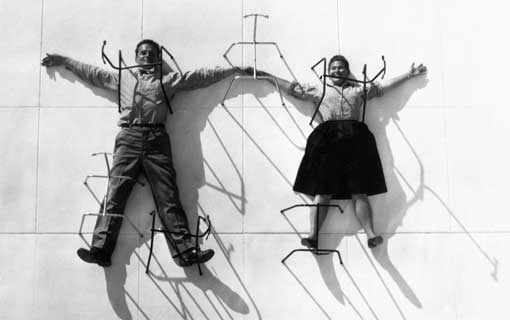
One of the many successes of AMC's much-honored Mad Men is its art direction. And now here's a documentary about two American designers who directly shaped the postwar modernism that's such an integral, sexy part of that series.
Monday night's film portrait Charles & Ray Eames: The Architect and the Painter (10-11:30 p.m. ET in many areas; check local airtimes) premieres in PBS' American Masters series as a colorful kaleidoscope of the furniture and other creative projects that made the married couple the face of American modern design in the '50s and '60s.
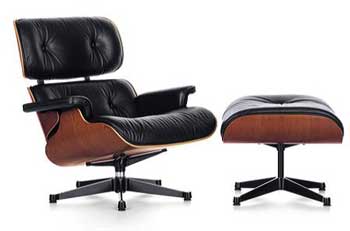
The Eameses' story is virtually canon among a whole generation of architecture and design students. It's a milestone model for young architects breaking through initially with furniture designs, recounting Charles' success as an upstart after the Second World War, selling a molded plywood chair to the national furniture manufacturer Herman Miller Company.
The Eameses were also a prototype for many collaborative designer couples to come, demonstrating how two designers could have it all -- a successful practice as professionals, and a rich, domestic life besides.
As smart and capable as the Eameses were, their personality and charm also fueled the publicity -- and the mystique -- of their Los Angeles-area firm in Venice, Calif. Charles had an infectious enthusiasm. He was trained as an architect, but had keen interests in filmmaking, graphic design and exhibit design, too.
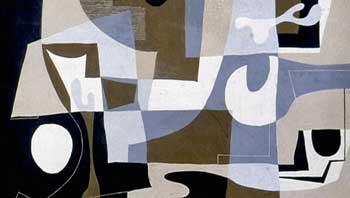
Ray, a painter who'd studied in New York under the renowned abstractionist Hans Hoffmann, brought vibrancy and color to the modernist work coming of the Eames office. The documentary rightfully credits her for an essential role in making the products commercially viable and successful.
Together, they were an American model -- in the way of earlier French architect and modernist auteur Le Corbusier -- to show how architecture, design and art were really all of the same; that a creative person could cross over many different disciplines and not be restricted by the confines of his or her own.
As a former employee remarks in the film, "Everything she did in design, she saw as an extension of her painting; everything he did in design, he saw as an extension of his architecture. For them, painter and architect weren't job descriptions, they were ways of looking at the world."
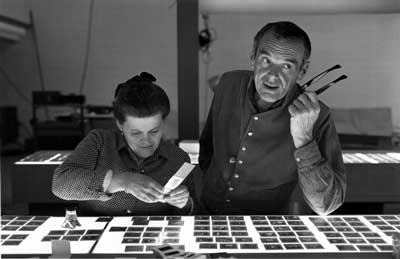
The Eameses said that creativity was often an issue of problem solving, of asking the right questions and learning what was needed to get to a new place, a new revelation, to what had not been seen before.
It was in this sense they argued for a method that stressed the process of discovery, not the final product. It was one that was focused on learning, rather than setting out to make something already done.
As such, the Eameses were practicing examples of designers who knew their toughest obstacle was their own complacency. For a generation of designers and architects, they stood as practitioners able to see their own work objectively, striving to be their own most unrelenting and best critics.
Charles & Ray Eames shows how this attitude and enthusiasm took them through almost 40 years of projects, including a World's Fair pavilion for IBM, marketing films for Polaroid, and of course, a line of furniture for Herman Miller that remains in production today.
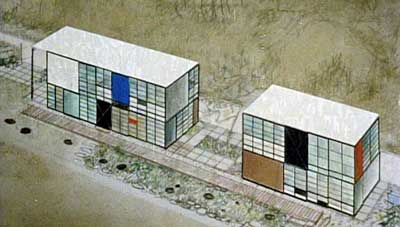
Maybe just as significant was the design and construction of their own home in Pacific Palisades, known today simply as The Eames House. It is two boxes, house and studio, and an early American example of a residence conceived as a prefabricated industrial "kit of parts." It's, as Corbusier said, a "machine for living," but filled with the decorative artistry that Ray brought to it.
Producers Jason Cohn and Bill Jersey go to great detail recreating the Eames experience, talking with a number of ex-employees, showing old handwritten notes and a model of the Eames office -- drafting rooms, wood shop, screening room, with a display of graphic art, collectibles and industrial objects that covered almost every surface.
You will immediately recognize the many Eames designs still around today, from the unmistakable Eames Chair to the ubiquitous molded fiberglass resin stacking chairs that have had thousands of copies and variations since.
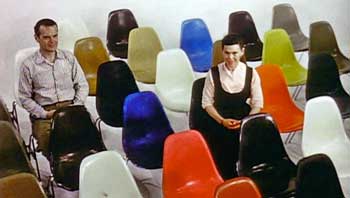
Looking at these very humanistic products of industrial processes, Charles' trademark expression of products, people and prices is often quoted: "We wanted to make the best, for the most, for the least." It was perhaps a foreshadowing of today's IKEA sensibility, where modernism is fun, available, colorful and affordable.
And of course, the Eames legacy stands as a centerpiece of AMC's Mad Men, nearly 50 years later, and now, four years running.